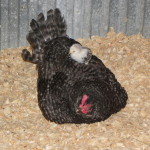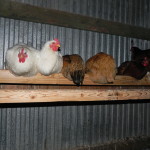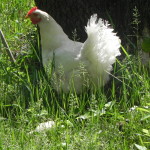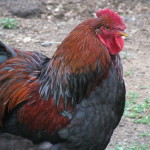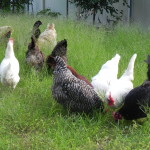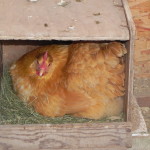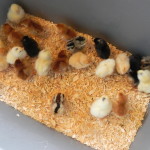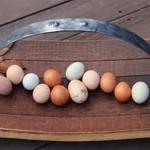Our Lives Shared With Chickens
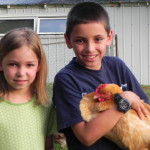
Children with
“Golden Hen.”
I’m not sure where it came from but somehow I became fascinated with chickens. I was eight years old living in suburban New Jersey, didn’t know anyone who had chickens, and no one in my family had ever had them. The interest came on strong 58 years ago and I’m still at it.
Dad and Mom were supportive and, I think, saw chickens as a way to learn. “Let’s build a coop and get a few,” Dad said, and soon he and I were building a chicken house just big enough to hold four hens. It was an education in basic carpentry. I bought four hens from Mr. Lawrence, the local egg man in an era when eggs, milk, and bread were delivered to the door.
The hens were my pride and joy. What I brought into the kitchen weren’t just eggs. They were brown jewels. Sometimes I’d just watch the hens after school and learned they are intelligent, communicate with each other through various calls, and are clean and odorless. They taught me that if I cared for animals humanely I’d receive an education, entertainment, and delicious food.
Chickens are part of our lives at Winding Pathways, and they continue to amaze Marion and me with their intelligence, comical antics, curiosity, and amazing ability to convert weeds, kitchen scraps, and insects into the jewels we bring into our kitchen.
CHICKENS BELONG IN MANY YARDS
A backyard chicken phenomenon is booming in America. Many towns have scrapped ordinances that once prohibited homeowners from keeping a few birds, and today thousands of families are experiencing the joy of poultry care. In the many backyard chicken workshops I’ve taught people say they want to have chickens for these reasons:
- “We don’t like the inhumane way commercial chickens are kept.”
- “Our kids will learn where food really comes from.”
- “The kids will learn responsibility by caring for animals.”
- “We’ll enjoy safe healthy eggs produced right in our yard by hens that consider weeds, kitchen scraps, and the treats and feed we provide gourmet fare.”
CHICKENS IN HISTORY
Chickens were domesticated thousands of years ago from wild jungle fowl that live in steamy Southeast Asia. Early humans valued them for the same reason we do today for their ability to convert things people can’t eat into delicious meat and eggs. Wherever people went they brought chickens along, even on long ocean voyages in sailing ships.
A chicken craze spread rapidly in Europe and the United States in the 1840s and 1850s when people nearly everywhere kept birds, took them to shows, and developed hundreds of standard breeds. Today there are thousands of different kinds of chickens. Among their many traits, they are amazingly diverse in size, feather and egg color, and temperament.
IS IT LEGAL?
A century ago families in huge cities, small towns and out in the country all kept chickens legally, but following the growth of suburbia many towns passed ordinances prohibiting the keeping of livestock. That usually included chickens. Ironically New York City never banned keeping chickens yet small towns in farm country did! In the past decade many towns have changed their ordinances to allow homeowners to keep small flocks. The best way to find out if your town allows chickens is to either call the city clerk or access ordinances on the municipal website.
ABOUT BREEDS AND BUYING CHICKENS
Marion and I have kept a few dozen different breeds over the past 40 years, and here are our favorites:
- Buff Orpingtons are gorgeous. We call them “golden hens” because of their color. They are quiet, tame and the friendliest breed. Although not the best of layers they aren’t slackers either. Each hen lays three or four brown eggs a week.
- Rhode Island Reds are one of the best brown egg layers. Marion’s from New England so how can we resist a breed from her native region? They aren’t as friendly as Orpingtons but lay more eggs.
- Australorps are glossy black. These Australian-developed chickens are quiet, tame and good brown egg layers.
- Light Brahmas are fluffy white with feathered legs and black heads and tails. They, too, are quiet, tame and one of the biggest of chicken breeds. They can weigh over ten pounds!
- Americaunas lay blue or green eggs. Known as “The Easter Egg Chicken” for the color of the eggs, they are good layers but production drops off in the winter.
- California Whites lay white eggs like fury. We generally avoid flighty and somewhat noisy white egg layers, but California Whites are reasonably quiet and lay an egg almost every day.
We enjoy these breeds for the above reasons and an array of brown, white, and blue/green eggs looks great in the cartons of eggs we give our friends.
We order a mix of compatible breeds.
Our golden Hen is friendly and quiet.
One of the best brown-egg layers.
We buy baby chicks each spring from Hoover’s Hatchery about a month before our last frost date. Mother Nature must have designed baby chicks for the postal service. After hatching there’s enough yolk remaining inside to nourish them for a couple of days -just long enough to make the trip from the Rudd, Iowa, hatchery to our home. Our brooder is a big cardboard box with two light fixtures hanging about a foot above the floor to keep the babies warm. Wood shavings cover the floor. We use an inexpensive waterer and feeder and a nifty and very safe light fixture we bought from Premier1. A 40 pound bag of chick starter rounds out early chick needs. We like the Nature Wise brand. The chicks live in the brooder for about a month. By then the weather’s warming and they’ve grown enough feathers to remain comfortable on cool spring nights. We set up the brooder in the middle of the coop and when chicks no longer need heat it we simply remove the cardboard box and they are in their permanent home.
We usually buy 25 chicks sold as “straight run”. This means about half will be baby hens, or pullets, and half will be baby roosters, or cockerels. We keep the hens for egg production and butcher the males when they are 12 to 15 weeks old. Because many people don’t want to deal with roosters, they purchase pullet chicks. Specialists at the hatchery are able to separate the genders. Many backyard chicken keepers like to buy a mix of breeds, and many hatcheries are happy to send a blend.
DETERMINING THE BEST BREED FOR MY FAMILY
With hundreds of breeds available it is hard to decide which is best. Fortunately there are excellent resources. One of the best web sites is My Pet Chicken. Click on breeds to find a chart with many breeds listed, approximately how many eggs each lays weekly, egg color, and more. Other websites have similar information. Hatchery catalogs are also a great way to learn. Check Hoover’s Hatchery or McMurray Hatchery. Each company will send a catalog, but information is on their websites. Finally, many books help newcomers learn how to select and care for chickens. One of our favorites is CITY CHICKS by Patricia Foreman. Another good one is THE CHICKEN WISPERER’S GUIDE TO KEEPING CHICKENS.
Most families who keep a few hens in a backyard coop prefer brown egg laying dual purpose breeds. These tend to be large in body size, calm in temperament, don’t fly well and are fun to be around. Our chickens aren’t pets. We sometimes eat them! But many people enjoy them as pets that lay eggs.
ARE THEY REALLY SMELLY, NOISY, AND DIRTY?
Nope. Like people and other animals, give chickens a clean place to live and plenty of elbow room and they are squeaky clean and don’t smell. Hens cackle a bit, especially when laying an egg, but the noise doesn’t carry far. Roosters can be noisy but few backyard flocks have one and hens will lay plenty of eggs without a rooster around. We put four or five inches of wood shavings, called litter, on the floor of the coop and make sure it stays dry. Wet litter smells. Chicken droppings are dry and become powdery and mix with the litter. Twice a year we scoop it out and add new wood shavings. We work the old litter into our garden and later harvest delicious lettuce, squash, pumpkins, beans and other crops nourished by our chicken compost.
People who claim chickens are filthy and stink often have only encountered them in commercial flocks where they are crammed together and have no access to fresh air, privacy, sunshine or living space.
Treat chickens in a way that you’d like to be treated and they will be clean and content.
Neighbors often have heard the smell myth, and the biggest tip in keeping chickens is to keep the neighbors happy. Our chickens are clean and never smell and we give our neighbors a dozen eggs now and then.
- This mama hen with chick on her back fluffs up clean wood chips.
- Chickens sheltered from the cold.
- Going on their third lay cycle, the girls are getting old.
WHAT YOU NEED
Fortunately keeping chickens has never cost us much money. Actually, of all the food animals -sheep, cattle, hogs, turkeys, geese and chickens the last is by far the least expensive and the only one well suited to suburban and urban life. Here’s what we have, and if you plan to keep hens what you will need.
COOP: Our coops are not elaborate. Dad and I made a simple one much like the garden sheds sold by big box lumber companies. Actually, one of those sheds could be easily modified to work. When we lived in Kansas we merely designated an 8X8 foot corner of a garage for our birds and made a 2X4 lumber frame with a simple door. We stapled one inch mesh chicken wire to it, and our coop was done. Our current coop is a bigger rectangle of lumber with wire over it in the corner of a small barn. We even salvaged the lumber from a scrap pile. At another home, our coop was made of a small manufactured garden shed. We kept chickens in it for nearly 30 years in the midst of suburbia.
Coops can be made or bought. Dozens are available for sale at some big box stores or through the Internet. These are often attractive but some aren’t very sturdy. You need a sturdy coop to keep out predators. Buying a coop is a great option for someone who isn’t handy with tools. Remember that chickens need at least four square feet of floor space per bird. More room is better.
ROOST: Inside the coop we install a roost. Chickens love to loiter on the roost and sleep there each night. We have woods near the house so we cut a sapling, trimmed it so it would fit in the coop and nailed it to braces on the wall. Works great. We’ve used a 2×4 roost but round off the edges to make it more comfortable to chicken feet.
FEEDER AND WATERER: We made our feeder of scrap wood but they can be purchased inexpensively at feed stores or on line. We use 10 quart buckets for water, but various waterers can also be purchased.
NESTS: We also made our nests of scrap wood and nailed them to the wall. They can be purchased but are so easy to make there’s no need to buy one. A 1”X12” board can be cut and made into a box about 14 inches long with one end open. Plan on one nest per two hens.
LITTER: We buy wood shavings in bales at the feed store and put a four to six inch layer on the floor.
POP HOLE AND RUN: Our chickens have an enormous run of about 2000 square feet. That’s plenty of room for 16 birds, but a smaller run would also work. Ours was a former dog run made of four foot high chain link fencing. That wasn’t high enough to keep the birds in so we bought 4 foot lengths of reinforcing bar at a lumber yard and attached them to the existing fence uprights with car radiator clamps. Then we stretched nylon netting between the rebar posts and attached it with cable ties. Works great. Total height is about six feet, and our heavy breed hens can’t fly over it. If they try, we clip the feathers of a wing. Between the coop and run is a pop hole. It’s just a small door about a foot wide and 18 inches high. We used a drill and Sawzall to cut a hole that size out of the plywood coop wall and used the piece cut out as a door. Two hinges hold one side and a husky raccoon-proof clasp holds it closed.
- Once small chicks are a few weeks old, they are big enough to explore a safe and indoor larger coop.
- Our chickens enjoy a spacious outdoor run with shrubs they can lounge and hide under at will.
Once small chicks are a few weeks old, they are big enough to explore a safe and indoor larger coop.
Our chickens enjoy a spacious outdoor run with shrubs they can lounge and hide under at will.
FOOD AND WATER: We enjoy watching our hens forage. They love the insects they catch in their large run and also eat weed seeds, grass and many plants. During the summer our unusually large run produces much of the food needed by our 16 chickens, but we always supplement it with manufactured feed. Baby chicks need feed with high protein, and we feed them CHICK STARTER for about their first four months. Then, about when the first egg appears we switch to LAYER feed. It is lower in protein but high in the calcium hens need to produce eggs and stay healthy. In winter nearly all their nutrition comes from purchased feed. Our first choice is the Nature Wise brand. Their layer mash is super nutritious and even has marigold extract to create bold dark egg yolks. We also feed our hens table scraps. They love most foods we eat. Even the little bits of rice remaining in the sink strainer after we wash dishes goes to the chickens. They love shrimp shells, vegetables, meat scraps, and much more but shun citrus peels. We don’t feed our hens potato peels or egg shells, although some people do. Ours go in the compost bin.
All chickens always need fresh water all the time. We use a commercial fount type waterer for chicks but buckets for mature birds. Many people prefer using large founts for their hens. Our coop is some distance from the house and a water source. It has a metal roof, and a few years ago we installed gutters and rain barrels. Now we merely open the tap of the rain barrel to fill our water buckets. When winter comes we remove the buckets and move a wood frame – again, made from scrap wood – into the coop. It cradles an electrically heated pan made to keep water unfrozen for dogs, but it works great for chickens. Fortunately, we have electric power in our barn/coop. Otherwise we would have to bring fresh water out to the birds a couple of times a day and remove frozen buckets. We did this for thirty-some years at previous homes.
SOME EXTRA TIPS
Hens are programmed by nature to lay the most eggs in spring and summer. We fool them by putting a timer controlled light in the coop. We start using it in October and stop in April. The timer is set to turn one light bulb on at 4 a.m. and off just after dawn. Using a light guarantees plenty of eggs during the winter baking season.
Raccoons, skunks, foxes, coyotes, domestic dogs, hawks and other predators love chicken dinners. Fortunately, most predators are active after dark when chickens are sleeping. Be sure to build a sturdy coop that doesn’t allow them to come in. And, remember to close the pop hole door as soon as the hens go to bed when the sun gets low. If you plan to return after dark, just “shoo” the hens in before you leave and close the pop hole door securely. We improvised some great sticks to use and walk slowly behind the chicken herding them to the door. Move quietly and calmly and after a few times doing this, the hens readily go in before dark.
Mosquitoes and gnats love meals of chicken blood. The windows of our coop have a double layer of wire. One layer is heavy duty with a 1X1 inch mesh that even the strongest raccoon can’t tear. On the inside is mosquito netting. The double wire system keeps out both bugs and larger chicken eaters.
Chickens can ride out cold weather but they don’t like drafts. Make sure the coop is draft free in winter. We close windows when it starts getting cold. The summer equivalent of a draft is a breeze, and chickens love cool breezes on hot day, so make sure the windows are open during warm months.
TO LEARN MORE
You are welcome to contact us at Winding Pathways. We’ll do our best to answer your chicken questions. Here are some final thoughts.
- Many feed and hardware stores as well as nature centers hold basic chicken workshops. Watch for announcements in social and traditional media. A class is a great way to learn chicken husbandry and meet other people with the same hobby.
- Dozens of websites provide information on chickens, chicken coops and where to buy chicks and supplies.
- Many magazines focus articles and ads on backyard chickens. Our favorite is BACKYARD POULTRY.
- A good book for urban and suburban families is CITY CHICKS by Patricia Foreman.
- Hatcheries have become full service. You can call for information or advice, and their paper and on line catalogs are filled with helpful information. You can buy chicks, feed, and supplies from many of them. In recent years we’ve ordered from Hoover’s Hatchery in Rudd, Iowa, and we’ve been pleased with their chicks.
- Premier1 Supplies has a full range of poultry equipment for sale. While they don’t sell chicks, they do sell nearly everything else you would need, including fencing.
- Pet stores, especially in urban areas, sell coops and supplies. Try Petco.
- For coops check Urban Coop Company.
HAVE FUN WITH YOUR CHICKENS!
- Our golden Hen is friendly and quiet.
- We order a mix of compatible breeds.
- An array of jewels. Photo by Lisa Ramlo.

